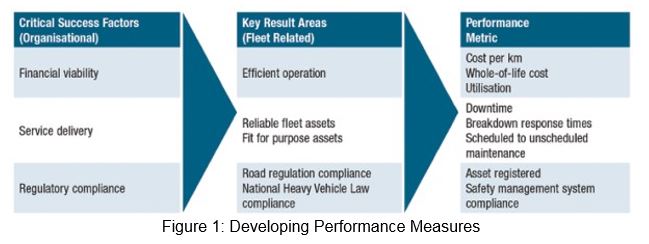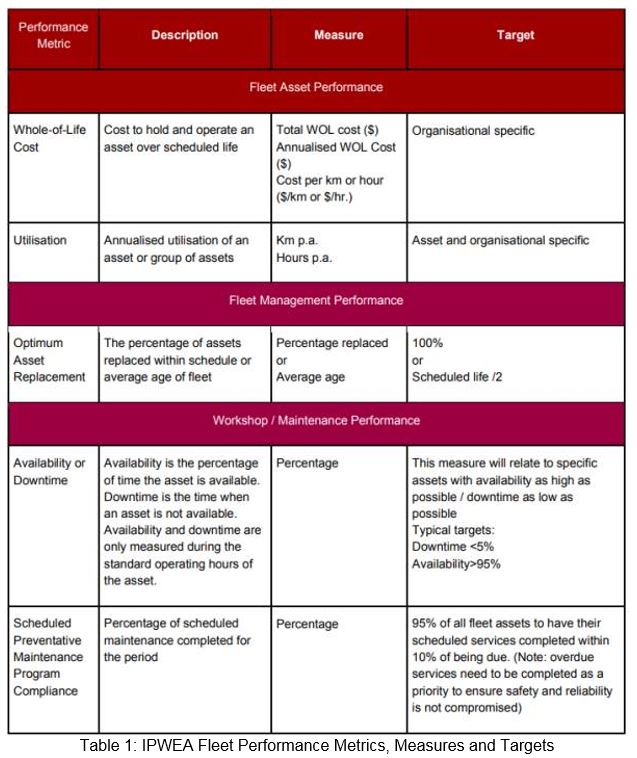By Rob Wilson – Director IPWEA FLEET
Managing Fleet Performance

Performance Measures and their Development
Performance management is essential for the ongoing management and improvement of plant and vehicle fleets. In essence, performance management is a cyclical process that requires the identification and understanding of objectives, the collection of relevant data, interpretation of information, decision making and management interventions.
Management guru Peter Drucker said, “If you can’t measure it, you can’t improve it.” This applies to a broad range of pursuits. In athletics, runners measure their times to monitor performance and as a basis for targeted training and improvement. Similarly, in fleet management we measure attributes of the fleet and monitor those metrics through reporting and review to guide decision making and to identify opportunities for improvement.
It is important that fleet practitioners apply a targeted approach to measuring and managing performance to ensure that the fleet is efficient (optimising cost and required levels of service) and effective (aligned to organisational objectives).
Designing effective performance measures that relate to higher level organisational objectives can be achieved using the following model:
- Start with the organisation’s Critical Success Factors (CSFs). These are typically documented in Corporate Strategy and Corporate Plan documents. CSFs are the outcomes that must occur to ensure the continued viability of the organisation. In a commercial business this might be about product development, customer experience and so on. For public sector organisations, CSFs might relate to service delivery and compliance. In any case, identifying the CSFs for your organisation is a crucial first step.

- Translate the CSFs into fleet-related Key Result Areas (KRAs). KRAs are factors that must be achieved if the organisation is going to achieve its CSFs. In fleet management KRAs may relate, for example, to efficiency, fitness-for-purpose, and compliance.
- Finally, identify performance measures that relate to the achievement of the KRAs. Once you have established your performance measures you can establish targets for your fleet.
This process effectively creates a line-of-sight between fleet performance and the organisational objectives it enables. This is demonstrated in Figure 1.1
Different Areas of Performance Management
When establishing fleet performance measures, it is important to consider various aspects of the fleet’s operation and management. IPWEA categorises Key Performance Measures as follows:
- Asset performance measures – focusing on the assets and how they are used. For example: the number of assets in the fleet (fleet establishment), whole-of-life cost (WOL cost), CO2 emission levels and so on
- Fleet management activities – relating to how the assets are managed and include measures on budget performance, asset replacement program compliance and residual values achieved versus market values
- Workshop and maintenance management – addresses maintenance and workshop performance matters such as repair turnaround times, availability, scheduled preventive maintenance program compliance, scheduled to unscheduled maintenance ratio, etc.
IPWEA goes on to list 27 Performance Metrics for fleet management in its primary fleet reference document, the Plant and Vehicle Management Manual.2 While these are not exhaustive it provides an insight into the types of performance metrics, associated measures and targets that can be applied across various aspects of a fleet operation. Some examples of the IPWEA metrics, measures and targets are demonstrated in Table 1 on p 46.
Analysis and Evaluation

Underpinning performance management is accurate and relevant data that can be analysed and interpreted to inform decisions and guide actions.
In today’s environment of in-vehicle-management-systems (IVMS), telematics and increasing connectivity, it is important not to lose sight of the bigger picture. Fleet practitioners need to focus on what is important and report exceptions.
Think of a monthly fuel spend report with literally thousands of transactions. You only want to address those transactions that fall outside defined parameters, for example: wrong fuel type, high consumption, tank overfill, etc. This approach focuses on areas requiring attention rather than those operating acceptably
In large and complex fleets, the fleet practitioner will not be able to review and address every performance report generated. In these circumstances the fleet practitioner becomes the facilitator, ensuring reports are generated and provided to the relevant line manager in a format that is easy to read, interpret and act on (e.g. dashboards).
The key with performance management is to measure what is important and use that data to drive improvement. Consider known areas of under-performance and understand your risks. These areas, considered through a lens of organisational priorities, will help you identify what needs to be measured.
Management Review and Performance Reporting The organisation’s senior leadership has an important role in overseeing the fleet operation. They have an obligation to apply due diligence and ensure the fleet is operating as required and meets regulatory compliance requirements. However, from a fleet practitioner’s perspective, management review also provides the opportunity to engage senior management, demonstrate the value of the fleet and the fleet management team, and raise risks associated with the operation.
Fleet performance reporting will often be in response to requests for information; however, routine reports should be scheduled and included in management and governance meetings (such as the Council or Board). Reporting should be tailored by design to the target audience, generally becoming more detailed for those further down the organisational hierarchy.
Summary
Fleet performance management is a key function of the fleet practitioner. Importantly, metrics must be developed that are relevant to the specific context of the fleet and the organisation it serves. Establishing and using fleet metrics ensures that the fleet is efficient, effective and supports broader organisational goals.
It is important not to focus narrowly on one aspect of the fleet but rather consider various perspectives such as the asset, fleet management performance, and maintenance.
Finally, use data, analysis and reporting thoughtfully. Consider what needs to be monitored and by whom. Importantly, fleet performance management not only enables effective management, it can demonstrate a proactive approach and supports collaboration in managing complex and expensive fleet assets.
This article is based on the principles and practices detailed in IPWEA’s primary fleet management reference the Plant and Vehicle Management Manual Ed4. The article was originally titled ‘Managing Fleet Performance Down Under’ and published in September 2020 edition of APWA Reporter magazine.